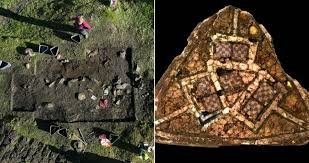
An impressive Viking woman’s 1,200-year-old grave is discovered by a metal detectorist.
Photo Credit ( Pixabay )
In southwest Norway, an intriguing Viking-era cemetery has been discovered that features jewellery and proof of continental ties.Three prominent women, who may or may not have been Scandinavians themselves, were buried there, and these ambiguities have given rise to intriguing theories.
The location was first discovered by amateur metal detectors and is situated at a farm named Skumsnes, close to the seaside in the Norwegian town of Fitjar. In late 2024, excavations revealed a range of items, including textile equipment and a frying pan, that identified the owners as female.
Coins and jewellery, such as a necklace of glass beads, a brooch that looks to have been fashioned from a metal book clasp, and one of the earliest coins ever struck in Denmark, further imply that the owners were extremely wealthy and well-known.
Archaeologist Søren Diinhoff of the University Museum of Bergen told Fox News Digital, “We believe that the clasp in the first grave could very well have come from a Bible in England or Ireland.” “It had been torn off and returned to Norway, where it was eventually used as a brooch for a woman.”
Some of the artefacts, which date to the middle of the ninth century, when the Viking era was at its height, most likely originated violently. Other trefoil brooches seem to have been recycled from Carolingian sword belt clasps, while other objects might have been imported from mainland Europe, according to Diinhoff and a study from Science Norway. Louis I, a Charlemagne descendant, struck ten of the eleven coins discovered in the burial.
Did these items come via trading, or were they captured during a raid? The term “Viking” may refer to both traders and raiders, and the ratio of traders to raiders changed depending on the location and time.
One theory is that the ladies were native to the continent and might have married into the community. But since there are no human bones in the graves, it’s hard to tell. Diinhoff and others initially assumed that the remains had broken down in the damp soil, which is a typical occurrence, in order to explain this. They later modified their plan so that the gravesite would more closely resemble a cenotaph or memorial where sacrifices were made.
published by the Bergen University Museum’s Søren Diinhoff
Given that the glass-beaded necklace was wrapped in a leather sack rather than being worn around a person’s neck, the archaeological team believes this to be more likely.
Additional Amazing Viking Age Discoveries: Archaeologists Verify Scandinavia’s Oldest Viking Ship Burial—Could Rewrite the Viking Age
The location of Skumsnes is crucial to understanding why this memorial is there. The excavation team is aware that Skumsnes was formerly home to a sizable manor farm, and given its proximity to the water, it’s possible that travellers and sailors frequently stopped there to relax.
“Strategic farms like Skumsnes are located below the level of royal estates,” Diinhoff told Science Norway. “Ships passing by were given shelter on behalf of the king, which probably brought in more money.”


